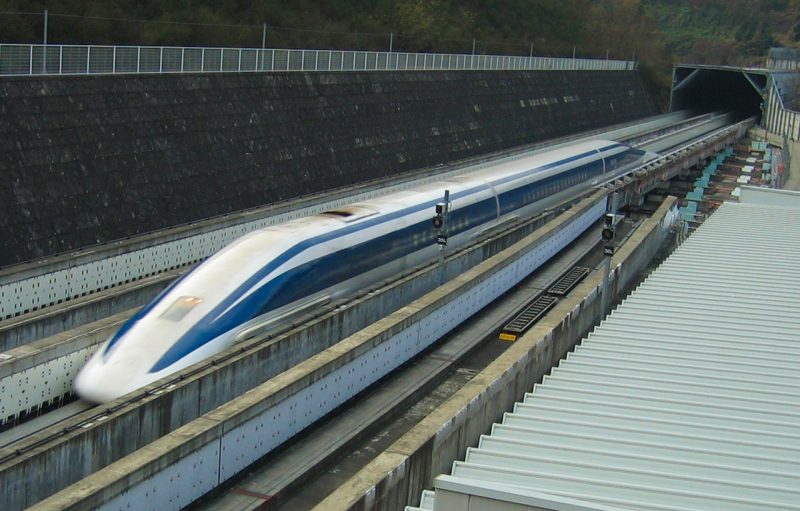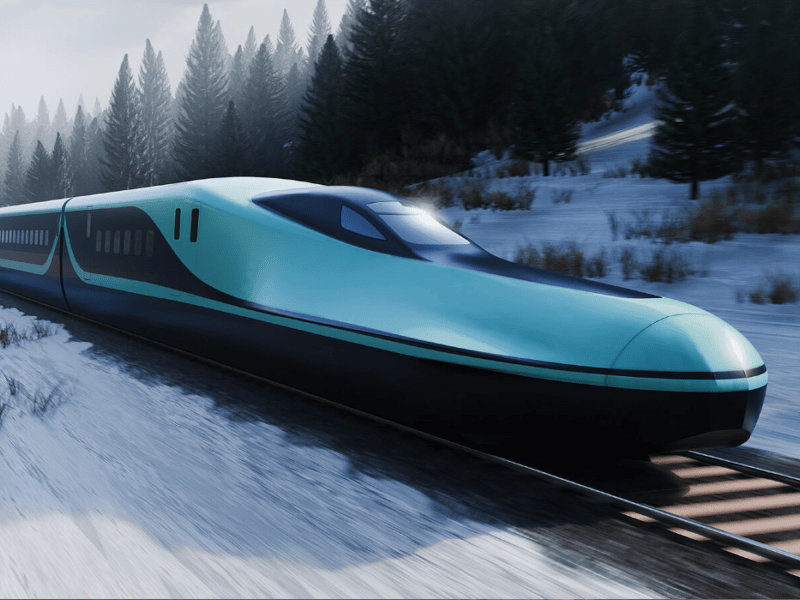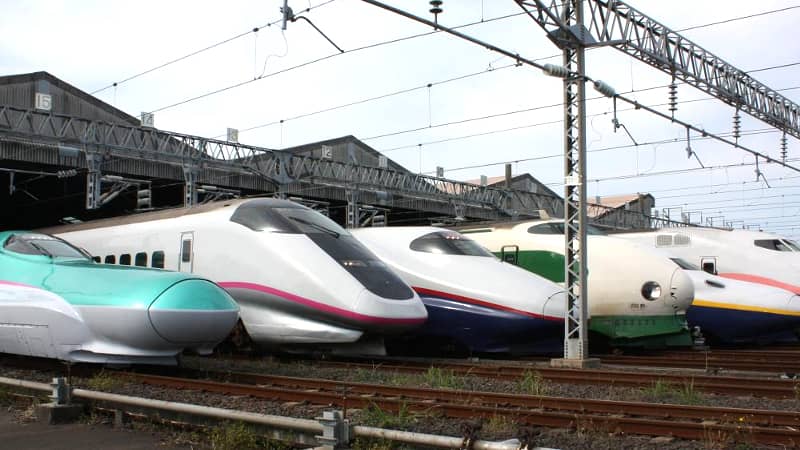Japan’s high-speed Shinkansen services are the fastest and most convenient way to get around the country. There have been a variety of types of bullet train series used on the lines since the first was inaugurated in 1964.
While some of the many types of bullet trains have been retired from use or upgraded to newer models as updated technology was developed, there are still many different trains in operation on each Shinkansen line.
This complete guide can help you identify the different types of Shinkansen models before you begin your journey with your JR Pass.
Table of Contents
Shinkansen train types in operation
The Shinkansen bullet trains currently in operation in Japan form part of the ‘next generation of models which began production in the late 1990s. They feature a number of upgraded features from the original bullet trains first inaugurated in the 60s.
500 series

Masterminded by German industrial designer Alexander Neumeister, the 500 series Shinkansen cost an estimated 5 billion yen to construct per train. Only 9 were ever built.
They were originally used on the primary Nozomi service on Tokaido Shinkansen and Sanyo Shinkansen lines. However, they were downgraded to the Kodama service between Shin-Osaka and Hakata in 2010.
The 500 series was designed to provide a smoother and safer ride than previous Shinkansen models. They achieved this by using dampers between cars to improve stability and computer-controlled active suspension in the running gear.
The front of the train was also designed to resemble a kingfisher’s beak in order to increase speed and reduce the noise level to improve passenger comfort.
- Max speed: 300 km/h (186 mph)
- Year of introduction: 1997
- Lines: Sanyo Shinkansen
E2 series

These Shinkansen, operated by JR East, come in either 8 or 10 car sets. The 10-car trains can be coupled with E3 series trains. A total of 502 E2 series trains were built between 1997 and 2010. Withdrawls of this Shinkansen type started in 2013.
- Max speed: 275 km/h (170 mph)
- Year of introduction:1997
- Lines: Tohoku Shinkansen, Joetsu Shinkansen, Hokuriku Shinkansen
E3 series

E3 series Shinkansen were built to coincide with the opening of the new Akita Shinkansen “mini-shinkansen” line between Morioka and Akita. The production process was overseen by industrial designer Kenji Ekuan.
Intitally only used for Komachi services, they were later introduced for use on Tsubasa services on the Yamagata Shinkansen Line.
Similar to the 400 series of trains, they were designed to have a smaller loading gauge than mainline Shinkansen trains to fit on the narrower “mini-shinkansen” lines.
These trains will gradually be replaced on Tsubasa services by the E8 series, which entered service in March 2024.
- Max speed: 275 km/h (170 mph)
- Year of introduction:1997
- Lines: Yamagata Shinkansen, Akita Shinkansen
E4 series

Like the E1 series, E4 trains are bi-level Shinkansen with double-decker cars designed to accommodate high commuter traffic in the areas around Tokyo and other urban zones.
The 8-car sets can be coupled together to form a 16-car train. This has a total capacity of 1,634 seated passengers.
- Max speed: 240 km/h (150 mph)
- Year of introduction:1997
- Lines: Tohoku Shinkansen, Joetsu Shinkansen, Hokuriku Shinkansen
700 series

Part of the next generation of Shinkansen produced in the late ’90s, 700 series trains were jointly designed by JR Central and JR-West.
They were originally used on the Hakata Minami Line, the Sanyo Shinkansen, and the Tokaido Shinkansen. However, they have since been withdrawn from service on the latter line.
These trains are distinctive for their flat ‘duck-bill’ front nose. This design reduces the piston effect when entering tunnels.
- Max speed: 300km/h (186mph)
- Year of introduction: 1999
- Lines: Sanyo Shinkansen, Tokaido Shinkansen
N700 / N700A series

N700 was an upgrade of the 700 series with tilting capability, allowing the train to maintain high speeds even in tight curves. It was introduced in 2007 on the Tokaido and Sanyo Shinkansen and in 2011 on the Kyushu Shinkansen lines.
The N700A was an evolution of the first design of the N700 introduced in 2013, which allowed an increase in the maximum speed of operation in curves. All the N700 have now been improved with the technology of the N700A, and are called N700a.
- Max speed: 300 km/h (186 mph)
- Year of introduction: 2007
- Lines: Tokaido Shinkansen, Sanyo Shinkansen, Kyushu Shinkansen
N700S series

On July 1st 2020, the N700S Shinkansen was launched on the Tokaido Shinkansen line. The suffix of the N700S stands for ‘supreme’ to signify the progression in design, technology, and comfort. It is the 6th-generation model of the N700 series and intended to be the best.
This new evolution incorporates a lithium-ion battery self-propulsion system, extremely useful during power outages or earthquakes.
- Max speed: 332 km/h (206 mph)
- Year of introduction: 2020
- Lines: Tokaido Shinkansen
800 series

The 800 series of Shinkansen abandoned the ‘duck-bill’ nose of the 700 series for a more conical shape. It received a Laurel Prize in 2005 for its design as a result.
This train operates on the Kyushu Shinkansen line run by the Kyushu Railway Company. They were introduced on Tsubame services in 2004.
- Max speed: 260 km/h (160 mph)
- Year of introduction: 2004
- Lines: Kyushu Shinkansen
E5 series

The E5 series of Shinkansen has operated on Tōhoku Shinkansen services since 2011. They have also run on Hokkaido Shinkansen services since 2016.
The trains incorporate technology derived from the experimental Fastech 360S train tested by JR East. They also feature an electric active suspension.
- Max speed: 320 km/h (200 mph)
- Year of introduction: 2011
- Lines: Tohoku Shinkansen, Hokkaido Sahinkansen
E6 series

These Shinkansen run as a Komachi “mini-shinkansen” service on the Tōhoku Shinkansen. They also run on the Akita Shinkansen from Tokyo to Akita.
They are operated by JR East. In 2014, E6 series trains replaced all the E3 models previously used on Komachi services.
- Max speed: 320 km/h (200 mph)
- Year of introduction: 2013
- Lines: Akita Shinkansen
E7 / W7 series

The E7 series of trains are based on the design of the earlier E2 series. They were jointly developed alongside the W7 series.
The cars are notable for the ‘Japanese’ theme employed both externally and internally. This combines both traditional and futuristic design elements.
Test runs for W7 series trains first began in 2014. These 12-car sets have continuously run on the Hokuriku Shinkansen since 2015.
That same year, the W7 trains were awarded the annual Blue Ribbon Award presented by the Japan Railfan Club, alongside the E7 series.
- Max speed: 275 km/h (170 mph)
- Year of introduction: 2013
- Lines: Hokuriku Shinkansen, Joetsu Shinkansen
E8 series

Intended to gradually replace the E3 series, E8 trains were implemented on Tsubasa services on the Yamagata Shinkansen Line in March 2024. They raise the top speed of the service from 275 to 300 km/h.
Like the E3s, E8 Shinkansen are 7-car trains consisting of 5 powered and 2 non-powered cars, and are fully equipped with active suspension.
The colorful exterior, which mixes white, purple, red, and yellow, is designed to evoke the rich landscape of the Yamagata region.
- Max speed: 300 km/h (186 mph)
- Year of introduction: 2024
- Lines: Yamagata Shinkansen
H5 series

H5 Shinkansen work in a pool alongside E5 trains series on Tohoku and Hokkaido Shinkansen services. However, it features a number of upgrades from the previous model, including an improved snowplow and stainless-steel underframe to protect the electronics in cold weather conditions.
- Max speed: 320 km/h (200 mph)
- Year of introduction: 2016
- Lines: Hokkaido Shinkansen, Tohoku Shinkansen
Old Shinkansen train types
Although these models are no longer in use on Shinkansen services, it is worth learning about the history of Japanese bullet trains to appreciate the vast improvements in the newer models.
0 series

The first generation of Shinkansen trains to be built, the 0 series started operating on the Tōkaidō high-speed line when it opened in 1964. Production of these trains continued until 1986, and they were eventually pulled from operation in 2008.
- Max speed: 220 km/h (137 mph)
- Years of operation: 1964-2008
- Lines: Tokaido Shinkansen, Sanyo Shinkansen
200 series

Production on these JR East trains commenced in 1980, curiously predating the 100 series of Shinkansen. While they share many of the same features of 0 series trains, they were designed to be lighter and more powerful to successfully navigate the mountain routes they ran on. They were also equipped with small snowplows fitted to the front.
- Max speed: 240 km/h (149 mph)
- Years of operation: 1982-2013
- Lines: Tohoku Shinkansen, Joetsu Shinkansen, Hokuriku Shinkansen
100 series

Although introduced after the 200 series, these trains were designated 100 series. This is because at the time, Shinkansen that ran east of Tokyo were given even numbers, while those running west were given odd numbers. The 100 series were designed with a more pointed nose than the 0 series.
- Max speed: 220 km/h (137 mph)
- Years of operation: 1985-2012
- Lines: Tokaido Shinkansen, Sanyo Shinkansen
300 series

300 series trains were the first to feature a ‘curved wedge’ front-end instead of a cone. They were used on the fastest Nozomi services when first introduced, and were awarded the Laurel Prize for outstanding functional and design features in 1993.
- Max speed: 270 km/h (170 mph)
- Years of operation: 1992- 2012
- Lines: Tokaido Shinkansen, Sanyo Shinkansen
E1 series

Alongside the E4 series, these were the first double-deck Shinkansen trains built in Japan. The exterior design of the original trains was notable for their “sky grey”, “silver grey”, and “peacock green” color schemes. This was replaced with a blue, white, and pink-striped design after refurbishment in 2003.
- Max speed: 240 km/h (149 mph)
- Years of operation: 1994-2012
- Lines: Tohoku Shinkansen, Joetsu Shinkansen
400 series

Originally designed as 6-car sets, 400 series trains received an extra 7th car in 1995 due to the popularity of the Tsubasa services on which they ran. The original design featured a silver-grey color scheme.
This was updated to a silver, dark-blue, and green pattern during refurbishments between 1999 and 2001. The trains were eventually retired in 2010.
- Max speed: 240 km/h (149 mph)
- Years of operation: 1992-2010
- Lines: Yamagata Shinkansen
Future Shinkansen train types
Japan Rail continues to develop new and improved models of Shinkansen to boost passenger comfort and safety and reach record-breaking speeds, most of which will be introduced in the near future.
E956 – Alfa-X

A 10-car experimental train that began testing in 2019, the Alfa X uses new technology to allow the craft to travel at some of the fastest speeds yet achieved on a Shinkansen line in Japan.
Painted in a metallic sheen to reflect the surrounding countryside, the trains are currently undergoing test runs on sections of the Tohoku Shinkansen line. It is also being tested on the Hokkaido Shinkansen line.
Alfa X trains have been designed to improve energy efficiency and passenger comfort, as well as to be more environmentally friendly. New safety features such as stability dampers will also help to further protect passengers in the event of an earthquake.
- Max speed: 400 km/h (250 mph)
- Year of introduction: 2019 (experimental phase)
- Lines: Tohoku Shinkansen, Hokkaido Shinkansen
L0 series – Maglev

Japan’s Maglev program aims to push the boundaries of the maximum speed possible on Shinkansen lines and eventually allow passengers to travel from Tokyo to Osaka in under an hour. The entire cost of construction is estimated to be around 55 billion US dollars.
The first stage in this project, the Chuo Shinkansen line, is currently in the testing phase and is expected to be inaugurated by 2027. Once operational, it will link Tokyo to Nagoya in roughly 40 minutes.
- Max speed: 500 km/h (310 mph).
- Expected year of introduction: 2027
- Lines: Chuo Shinkansen
E10 series

Operator JR East unveiled its new E10-series Shinkansen in March 2025, which is slated to replace the E2 and E5 bullet trains currently in service until 2030.
Enhanced E10 safety features include L-shaped vehicle guides to prevent derailing during earthquakes, together with lateral dampers which will also reduce shaking. An improved braking system will also shorten stopping distances.
JR East collaborated with a UK design studio who drew inspiration for the E10’s aesthetic from cherry blossom petals and the mountains of the Tohoku region. This new Shinkansen bullet train is scheduled to begin test runs in 2027.
- Max speed: 320 km/h (200 mph).
- Expected year of introduction: Spring 2030
- Lines: Tohoku Shinkansen
Train services by shinkansen line
Below you can find a complete list of the types of services avaialble on each Shinkansen line:
Tokaido, Sanyo and Kyushu Shinkansen:
- Nozomi (fast, Tokaido and Sanyo)
- Hikari (semi-fast, Tokaido and Sanyo)
- Hikari Rail Star (semi fast, Sanyo)
- Kodama (local, Tokaido and Sanyo)
- Sakura (semi-fast, Sanyo and Kyushu)
- Mizuho (fast, Sanyo and Kyushu)
- Tsubame (local, Kyushu)
Tōhoku, Hokkaido, Yamagata and Akita Shinkansen:
- Hayabusa (fast, Tohoku & Hokkaido, using E5 series/H5 series trains)
- Hayate (local, Tohoku & Hokkaido. The fast service was discontinued in 2019)
- Yamabiko (semi-fast, Tohoku)
- Nasuno (local, Tohoku)
- Aoba (discontinued)
- Komachi (Akita)
- Tsubasa (Yamagata)
- Toki / Max Toki (semi-fast, Jōetsu)
- Tanigawa / Max Tanigawa (local, Jōetsu)
- Asahi / Max Asahi (discontinued)
- Kagayaki (fast, Hokuriku)
- Hakutaka (semi-fast, Hokuriku)
- Tsurugi (local, Hokuriku)
- Asama (local, Hokuriku)
